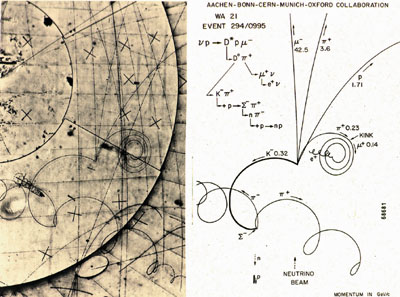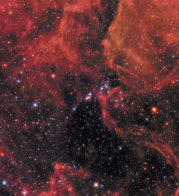Neutrinos have been a mainstay of CERN’s research until September, when a generation of studies at the SPS synchrotron came to an end.
Research using neutrino beams began at CERN in 1963 using particles from the PS proton synchrotron. The highlight of the PS neutrino act was the discovery of the weak neutral current in 1973, and in 1977 the new SPS synchrotron took over the neutrino role.
Twenty-one years later, with the completion of the CHORUS and NOMAD experiments in September, an era of neutrino physics at least in its traditional setting of the West Area of the SPS has now drawn to a close.
Plans for this facility were laid in 1971 during plans for CERN’s “300 GeV Project” which became the 450 GeV SPS. The BEBC bubble chamber, then under construction, was a fixed point through which the beams had to pass, but two possibilities were considered for the primary proton target, where the pion and kaon parents of the neutrinos would be produced. The alternatives were a surface beam, or a beam beginning at the SPS, 40 m below ground and pointing upwards at an inclination of 4.25°. The “underground” solution was chosen because it allowed operation at any energy possible from the SPS.

In addition to BEBC, an electronic detector, that of the WA1 collaboration, was approved and both were available when the first SPS neutrino beams appeared early in 1977.
Over the years four types of beam have been available: the basic diet of wide-band horn-focused beams; the added spice of narrow-band beams using momentum-selected parent particles; “beam dump” beams obtained by dumping the proton beam into a massive target; and low-energy beams from the smaller PS accelerator.
This versatility allowed a wide variety of physics to be covered. A key factor also was the provision of detectors to monitor the flux of the accompanying muons, which allowed absolute determinations of the neutrino flux, always a problem in neutrino beams.
In 1977 BEBC was joined by the Gargamelle bubble chamber, moved from the South West Area at the PS, scene of the neutral current discovery. A year later the 100 t CHARM electronic detector became operational.
First studies
Initial physics centred on studies of neutral currents, on the quark structure of matter, and on quantum chromodynamics (QCD), the field theory of quarks and gluons. The results obtained were, and still are, still important input for tests of the Standard Model.
The targets for the neutrinos were “heavy” nuclei (iron in WA1 and marble in CHARM, freon or propane in Gargamelle, or neon in BEBC) or “free” nucleons in hydrogen and deuterium in BEBC. The latter enabled the distributions of up and down quarks in the nucleon to be measured. As well as BEBC, there was also a 1.5 t liquid hydrogen target upstream of the WA1 detector.
In December 1997 a novel type of experiment was carried out – the “beam dump”. The primary SPS proton beam was pointed toward the detectors and dumped into an intervening massive copper target. In such a target the pions and kaons, the usual parents of neutrinos, do not have time to decay before being absorbed, so that the neutrino supply from these sources is reduced by a factor of more than a thousand. However, any neutrinos produced in the decays of very short-lived parents will be unaffected. In fact such “prompt” neutrinos were observed and are now known to be due to the decays of charmed particles, although at the time measurements had claimed that charm production by protons was much too small. These initial results were confirmed by further dump experiments in 1979 and 1981, which also set limits on the production of tau neutrinos.
Gargamelle took part in the first beam dump experiment and in wide-band and narrow-band running in 1978. However, in October of that year leaks detected in the chamber were found to be due to deep cracks in the steel vessel, which unfortunately it was not possible to repair. However, in its short career at the SPS, Gargamelle nevertheless succeeded in observing for the first time a touchstone weak interaction the purely leptonic process in which a muon neutrino hits an electron, producing an electron neutrino and a muon. After a few years gathering rust in the West Area, Gargamelle is now proudly displayed in CERN’s Microcosm Park.

During its lifetime BEBC recorded many thousands of neutrino interactions. This was much less than in the electronic detectors, but the enormous amount of detail available in bubble chamber pictures allowed the study of particular final state particles, notably charmed particles, and the measurement of production cross-sections, masses and decay modes.
During 1984, WA1 and CHARM made very accurate determinations of basic electroweak parameters in high statistics studies of neutral-current interactions using the narrow-band beams. These measurements still serve as an “anchor point” to which the precision high-energy measurements made at CERN’s LEP electronpositron collider can be related, giving an insight into electroweak radiative corrections, and hence to the mass of the Higgs boson.
Throughout the lifetime of the West Area facility, the possibility of neutrino oscillations electron, muon and tau neutrino types transforming among themselves has been the object of continual conjecture and study. The well understood neutrino beams and the variety of detectors available allowed very stringent limits to be placed on such oscillations, within the kinematic limits imposed by the beam energies and the locations of the detectors.
Narrow band, wide band and beam-dump beams have all been exploited to search for neutrino oscillations. The existence of oscillations runs counter to neutrino orthodoxy, requiring that neutrinos have mass.
In order to explore very small neutrino masses, a special neutrino beam was derived from the CERN PS with a new “near station” 130 m from the target. WA1, CHARM and BEBC took part in this search in 1983-84. However, no oscillation evidence was found.
Muon neutrinos
Of particular interest is the possibility of muon neutrino/tau neutrino oscillations. With the West Area well served with muon neutrinos, specialized detectors (NOMAD using kinematic techniques, and CHORUS using nuclear emulsion to observe the final state tau leptons) began operation in 1993.
From 1983-91 the WA79 (CHARM II) experiment detected several thousand events in which a muon (anti)neutrino scatters off an electron, remaining a a muon (anti)neutrino. (One event of this type, observed in Gargamelle in 1972, was the precursor of the discovery of neutral currents.) These purely leptonic interactions provided a valuable measurement of electroweak mixing, free of uncertainties due to the hadronic structure of nuclear matter.
However, the end of neutrino beams in the West Area does not mean the end of neutrino physics at CERN. The evidence for neutrino oscillations in neutrinos from the Sun, from cosmic rays in the atmosphere and from accelerators, indicates that much longer “base lines” are required.
One possibility, not pursued at CERN, was to take advantage of the upward inclination of the West Area beam and install a detector in the Jura mountains 17 kilometres from the target. Instead, interest has turned to the Neutrino Beam for Gran Sasso project in which a beam generated at CERN could be pointed south-east towards the Italian Gran Sasso Laboratory, 730 kilometres away.





